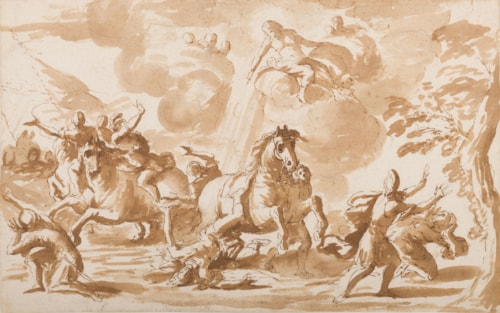
Guillaume COURTOIS
Saint-Hippolyte 1628 - Rome 1679
Biography
Born in Franche-Comté in eastern France, Guillaume Courtois was the son of the obscure painter Jean-Pierre Courtois, with whom it is thought he received his initial training. As a child, he travelled with his father and brothers to Italy, around 1636, visiting Milan, Bologna, Venice, Florence and Siena. Courtois was to spend most of his adult life living and working as a history painter, draughtsman and printmaker in Rome. He was known in Italy as Guglielmo Cortese, and was also given the nickname ‘Il Borgognone’, in respect of his Burgundian origins. (His elder brother, the battle painter and sometime Jesuit priest Jacques Courtois, known in Italy as Giacomo Cortese, was given the same nickname. The two brothers sometimes worked together, notably on the extensive decoration of the oratory of the Collegio Romano, next to the church of Sant’Ignazio in Rome.) Known in particular as a painter of religious and mythological scenes, the younger Courtois came under the influence of Pietro da Cortona, with whom he may have studied in the 1650s, although this remains a matter of some debate.
Courtois’s first major public commission was the fresco decoration of the Roman church of San Marco, commissioned by Niccolò Sagredo. Other early works include a Battle of Joshua for the Quirinal Palace and an altarpiece of The Martyrdom of Saint Andrew for the church of Sant’Andrea al Quirinale in Rome. Between 1658 and 1659 he contributed to the decoration of the Palazzo Pamphili at Valmontone. In 1661 he painted an Assumption for the church of San Tomasso da Villanova in Castelgandolfo, designed by Gian Lorenzo Bernini, and his later work shows the influence of Carlo Maratti. Courtois also painted a number of collaborative works with artists such as the still life painter Abraham Brueghel and the landscapist Gaspard Dughet.


